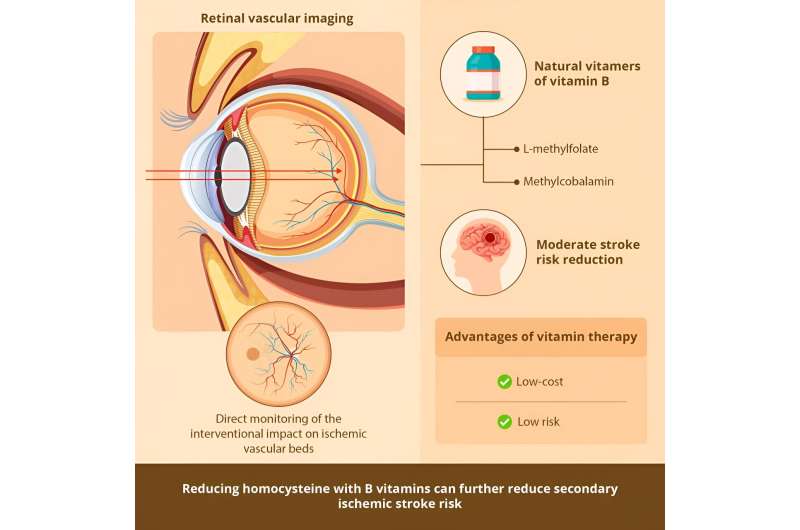This article has been reviewed according to Science X's editorial process and policies. Editors have highlighted the following attributes while ensuring the content's credibility:
fact-checked
trusted source
proofread
Researchers claim vitamin supplements and new technology can help prevent secondary stroke

A team of researchers, including one from the University of Maine, argue that vitamin supplements can help prevent secondary strokes. They also advocate for the value of new technologies in eye research to verify these findings.
Homocysteine is an amino acid associated with stroke and secondary stroke when elevated above normal levels. B vitamins and folate, also known as vitamin B9, can help lower levels of homocysteine and stroke, according to a peer-reviewed editorial published in the journal Pharmacogenomics and Personalized Medicine.
Elevated homocysteine is the result of genetic mutations or inadequate stores of vitamins B6, B12, folate and riboflavin (B2). Lowering it is relatively inexpensive because it can be achieved through vitamin supplementation.
The research team recommends lowering high levels of homocysteine with low doses of folic acid and cyanocobalamin, which treats vitamin B9 and B12 deficiencies, respectively; or better, with the natural vitamin forms found in food, L-methylfolate and methylcobalamin.
Merrill "Pete" Elias, professor emeritus with the UMaine Department of Psychology, Institute of Medicine and Graduate School of Biomedical Sciences and Engineering, co-authored the editorial with colleagues from the University of Arkansas as part of the Maine-Syracuse Longitudinal Study (MSLS), which he directs.
In the editorial, researchers also argued that the 2021 Guideline for the Secondary Prevention of Ischemic Stroke should be revised to include the use of vitamins to reduce homocysteine, specifically folic acid and low dose cyanocobalamin, or better, L-methylfolate and methylcobalamin.
Additionally, the authors urged the use of new ophthalmologic technology for monitoring risk of stroke and secondary stroke. The research team recommends retinal vascular imaging because this is a noninvasive method for evaluating central nervous system perfusion, which plays a crucial role in stroke.
"The eye is the window to the brain. Thus vascular imaging will play an important role in monitoring the effectiveness of stroke prevention strategies such as the new 2021 Guidelines," Elias says.
More information: Craig Brown et al, Homocysteine Reduction for Stroke Prevention: Regarding the Recent AHA/ASA 2021 Prevention of Stroke in Patients With Stroke and Transient Ischemic Attack, Pharmacogenomics and Personalized Medicine (2023). DOI: 10.2147/PGPM.S426421


















